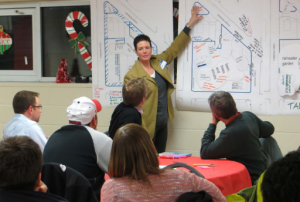Protecting against floods with a community-designed park

The inaugural New Jersey One Water Awards, sponsored jointly by Jersey Water Works, the Association of Environmental Authorities of New Jersey, and the New Jersey chapter of the American Water Works Association, were developed to honor initiatives that exemplify the principles of the One Water approach: the belief that all water- stormwater, drinking water, wastewater- has value that can be unlocked by implementing sustainable, inclusive, and integrated water resource management practices.
Protecting against floods with a community-designed park
The southwest corner of Hoboken has long struggled with flooding–a chronic problem that came into sharp focus during Hurricane Sandy. The area sits on a former marsh that had been filled in and paved, making it vulnerable even to small storms. In response to a grassroots civic movement to address flooding and a lack of green space, the City of Hoboken developed Southwest Park, New Jersey’s first resiliency park.

The city purchased an underutilized parking lot and hired Starr Whitehouse Landscape Architects and Planners to design the park. Over the course of three public workshops, the city gathered input from residents to determine community priorities. Residents evaluated programming concepts and provided suggestions. The final design plan was presented to the community and received popular approval. The completed park, which opened on Sept. 22, 2017, features rain gardens, wood deck paths, a granite amphitheater, a dog run, tables and chairs, a bike sharing station, public WiFi, a central plaza, restrooms, and a perimeter pedestrian mall that can accommodate local vendors and food trucks.
Three stormwater management systems capture stormwater: open-jointed pavers, rain gardens, and vegetated bioswales. The park’s urban plaza area makes use of open-jointed pavers to create a paved area that is completely permeable. It sits on a bed of gravel that filters stormwater before it returns to the watershed. The rain gardens feature native plants and sandy soil to filter water. Excess water flows into one of three stormwater detention basins that are located underground. The bioswales capture water from adjacent roadways and sidewalks, filtering pollutants and directing excess water to the stormwater detention basins.

The three stormwater detention basins capture excess water during heavy storms, with the capacity to hold up to 71,000 gallons. After a storm, the detained water is released gradually into the combined sewer by a sensor that controls the rate of flow. With the stormwater detention basins and stormwater management systems combined, the park can store up to 190,000 gallons in total–enough to provide flood relief beyond the boundary of the park.
Taking advantage of the park’s public-facing nature, the City of Hoboken has installed informational signs to educate the public about stormwater management and environmental issues. The park functions simultaneously as a stormwater mitigation system, public space, and an educational tool.
Partners: New Jersey Environmental Infrastructure Trust, County of Hudson, North Hudson Sewerage Authority